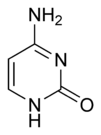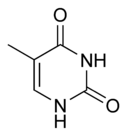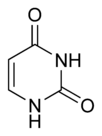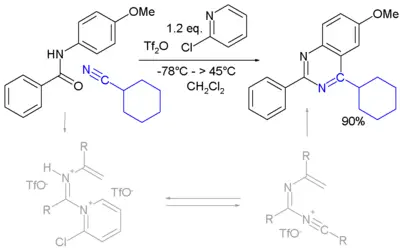Pyrimidine
| Pyrimidine | |
|---|---|
| Chemical name | Pyrimidine |
| Chemical formula | C4H4N2 |
| Molecular mass | 80.08796 g/mol |
| CAS number | [289-95-2] |
| Density | 1.016 g/cm3 |
| Melting point | 20–22 °C |
| Boiling point | 123–124 °C |
| SMILES | C1=NC=NC=C1 |
| Disclaimer and references | |
Pyrimidine is a heterocyclic aromatic organic compound similar to benzene and pyridine, containing two nitrogen atoms at positions 1 and 3 of the six-member ring [1]. It is isomeric with two other forms of diazine.
Three nucleobases found in nucleic acids, namely cytosine, thymine, and uracil, are pyrimidine derivatives:
In DNA and RNA, these bases form hydrogen bonds with their complementary purines. Thus the purines adenine (A) and guanine (G) pair up with the pyrimidines thymine (T) and cytosine (C) respectively.
In RNA, the complement of A is U instead of T and the pairs that form are adenine:uracil and guanine and cytosine.
These hydrogen bonding modes are for classical Watson-Crick base pairing. Other hydrogen bonding modes ("wobble pairings") are available in both DNA and RNA, although the additional 2'-hydroxyl group of RNA expands the configurations through which RNA can form hydrogen bonds.
Chemical properties
A pyrimidine has many properties in common with pyridine, as the number of nitrogen atoms in the ring increases the ring pi electrons become less energetic and electrophilic aromatic substitution gets more difficult while nucleophilic aromatic substitution gets easier. An example of the last reaction type is the displacement of the amino group in 2-aminopyrimidine by chlorine [2] and its reverse [3]. Reduction in resonance stabilization of pyrimidines may lead to addition and ring cleavage reactions rather than substitutions. One such manifestation is observed in the Dimroth rearrangement.
Compared to pyridine N-alkylation and N-oxidation is more difficult and pyrimidines are also less basic: the pKa value for protonated pyrimidine is 1.23 compared to 5.30 for pyridine.
Pyrimidine biosynthesis
New synthesis of pyrimidine
Unlike purines, pyrimidines are assembled before being attached to 5-phosphoribosyl-1-pyrophosphate (PRPP). The first step begins with formation of carbamoyl phosphate by carbamoyl phosphate synthetase II.This is the regulated step in the pyrimidine biosynthesis. The second major step is the creation of carbamoyl aspartic acid formed by aspartic transcarbamolyase (aspartate carbamoyl transferase).The next reaction involves dehydration of the acid catalysed by the enzyme dihhydroorotase to form hydroorotate. Dihydroorotate then enters the mitochondria where it is oxidised through removal of hydrogens to form orotate. This is the only mitochondrial step in nucleotide rings biosynthesis. The enzyme involved is dihydroorotate dehydrogenase (the only mitochondrial enzyme). Once orotate is eventually formed, it is combined with PRPP to form orotidine 5' monophosphate OMP which is decarboxylated in a reaction catalysed by OMP decarboxylase to form uridine 5' monophosphate. UMP is then converted to UDP catalysed by nucleotide diphosphokinase which is further phosphorylated to UTP by CTp synthase. This later reaction eventually leads to the formation of cytidine 5'triphosphate and glutamine is utlized.
Pyrimidine catabolism
Pyrimidines are ultimately catabolized (degraded) to CO2, H2O, and urea. Cytosine can be broken down to uracil which can be further broken down to N-carbamoyl-β-alanine. Thymine is broken down into β-aminoisobutyrate which can be further broken down into intermediates eventually leading into the citric acid cycle. β-aminoisobutyrate acts as a rough indicator for rate of DNA turnover.
Organic synthesis
Pyrimidines can also be prepared in the laboratory by organic synthesis. Many methods rely on condensation of carbonyls with amines for instance the synthesis of 2-Thio-6-methyluracil from thiourea and ethyl acetoacetate [4] or the synthesis of 4-methylpyrimidine with 4,4-dimethoxy-2-butanone and formamide [5].
A novel method is by reaction of certain amides with carbonitriles under electrophilic activation of the amide with 2-chloro-pyridine and trifluoromethanesulfonic anhydride [6]:
See also
- Pyrazine, an analog with the nitrogen atoms in positions 1 and 4.
- Pyridazine, an analog with the nitrogen atoms in positions 1 and 2.
- Simple aromatic rings
- ANRORC mechanism
- Template:ChemicalSources
ReferencesISBN links support NWE through referral fees
- ↑ Heterocyclic Chemistry (3rd Edition) Thomas. L. Gilchrist ISBN 0-582-27843-0
- ↑ Organic Syntheses, Coll. Vol. 4, p.182 (1963); Vol. 35, p.34 (1955) Link
- ↑ Organic Syntheses, Coll. Vol. 4, p.336 (1963); Vol. 35, p.58 (1955) Link
- ↑ Organic Syntheses, Coll. Vol. 4, p.638 (1963); Vol. 35, p.80 (1955) Link
- ↑ Organic Syntheses, Coll. Vol. 5, p.794 (1973); Vol. 43, p.77 (1963) Link
- ↑ Single-Step Synthesis of Pyrimidine Derivatives Mohammad Movassaghi and Matthew D. Hill J. Am. Chem. Soc.; 2006; 128(44) pp 14254 - 14255; (Communication) DOI:10.1021/ja066405m
| Nucleic acids edit |
|---|
| Nucleobases: Adenine - Thymine - Uracil - Guanine - Cytosine - Purine - Pyrimidine |
| Nucleosides: Adenosine - Uridine - Guanosine - Cytidine - Deoxyadenosine - Thymidine - Deoxyguanosine - Deoxycytidine |
| Nucleotides: AMP - UMP - GMP - CMP - ADP - UDP - GDP - CDP - ATP - UTP - GTP - CTP - cAMP - cGMP |
| Deoxynucleotides: dAMP - dTMP - dUMP - dGMP - dCMP - dADP - dTDP - dUDP - dGDP - dCDP - dATP - dTTP - dUTP - dGTP - dCTP |
| Nucleic acids: DNA - RNA - LNA - PNA - mRNA - ncRNA - miRNA - rRNA - siRNA - tRNA - mtDNA - Oligonucleotide |
Credits
New World Encyclopedia writers and editors rewrote and completed the Wikipedia article in accordance with New World Encyclopedia standards. This article abides by terms of the Creative Commons CC-by-sa 3.0 License (CC-by-sa), which may be used and disseminated with proper attribution. Credit is due under the terms of this license that can reference both the New World Encyclopedia contributors and the selfless volunteer contributors of the Wikimedia Foundation. To cite this article click here for a list of acceptable citing formats.The history of earlier contributions by wikipedians is accessible to researchers here:
The history of this article since it was imported to New World Encyclopedia:
Note: Some restrictions may apply to use of individual images which are separately licensed.




